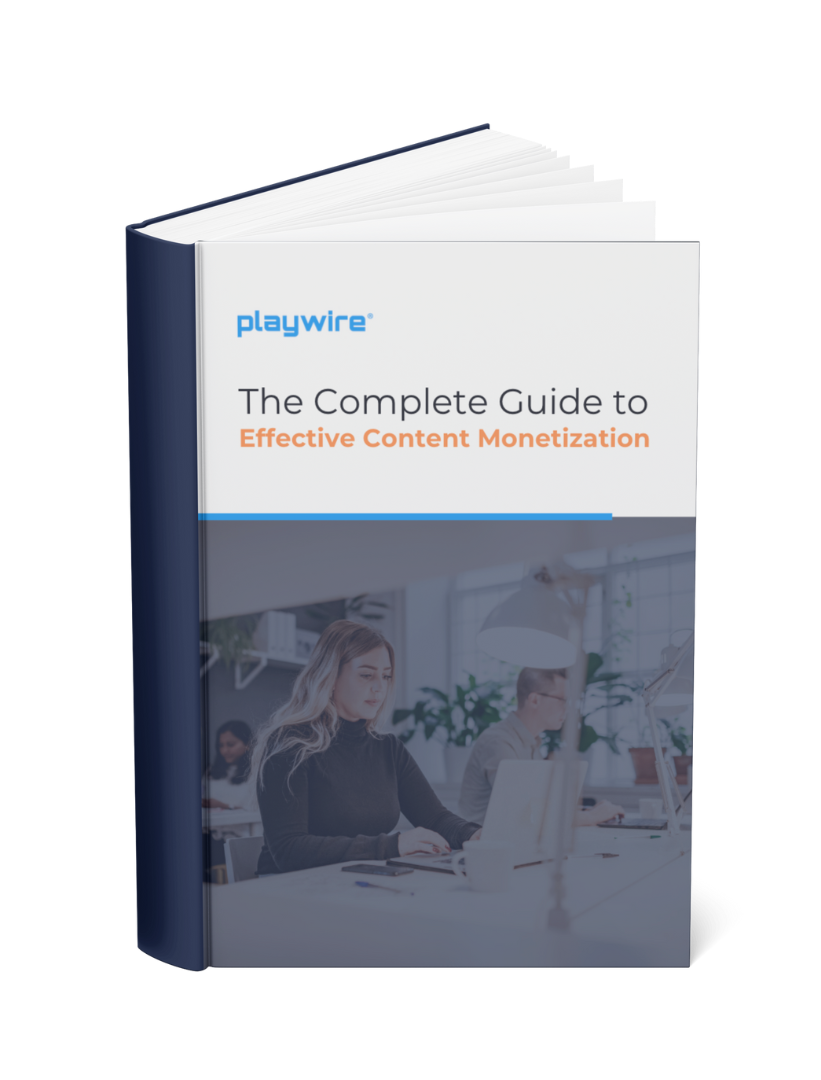
The Complete Content Monetization Resource Center
What is Content Monetization?
Content monetization is the practice of positioning the content you create to make money online. Publishers, bloggers, and influencers often make money by partnering with trustworthy brands who want to reach their followers.
Some common content monetization strategies include digital advertising, sponsored content, affiliate links, branded or digital products, subscriptions or memberships, and consulting or coaching.

The Complete Guide to Effective Content Monetization
GUIDE
Learn everything you need to know about content monetization with this comprehensive guide from Playwire's monetization experts.
Content Monetization:
How to Build a Content Marketing Strategy to Monetize Your Website More Effectively
Learn how to prioritize your audience, diversify your content strategy and monetization channels, establish a well-defined brand strategy, and monitor your site performance for more effective content monetization.Understanding the Important Relationship Between Brand Strategy and Monetization
A unique brand identity is the foundation of successful content monetization. Learn how to build a brand strategy and discover tips for finding the most effective way to monetize your content in conjunction with your brand to amplify your revenue potential.Building an Omnichannel Strategy: How to Do it and Why it's Important for Effective Content Monetization
Explore the importance of building a successful omnichannel strategy for content monetization. What is it? Why is it important? And how can you build the most effective one for steadily increasing revenue?
The Importance of Integrating Website and Social Media Content
Explore practical publisher strategies to help boost your online visibility, deepen your connection with your audience to increase user engagement, and ultimately, supercharge your website revenue.
Playwire Live: Schema and SEO for Publishers and Content Creators
ARTICLE + VIDEO
From Google’s latest algorithm updates to the infiltration of AI-generated content across every corner of the Internet, the current SEO landscape is dynamic, unpredictable, and as a result, creating a myriad of new challenges for publishers.
To better understand this new era for SEO, a critical component of effective content monetization, we sat down for an important Playwire Live episode with technical SEO expert and owner of Narrative SEO, Franco Valentino.
During the virtual event, Franco delivers his “10 SEO Must-Haves,” a framework any publisher or content creator can use to cover the non-negotiables of SEO and ensure their websites are technically sound and optimized for search. Click below to dig in!
to Drive Increased Revenue
Advanced Yield Analytics Drive Strategic Business Decisions for GTPlanet

2X
36%
Frequently Asked Questions About Content Monetization
What are the best content monetization strategies?
While there are many different content monetization strategies, the most common include:
- Ads: One of the best ways to drive steady, long-term website revenue. But how you incorporate ads and what tools you work with to do so really matters.
- Sponsored Content: Paid content that promotes a brand or product, which can be lucrative and give publishers more control over what you place on your platform, but there is a right and wrong way to deliver this type of content.
- Affiliate Marketing: Here, publishers promote products through affiliate links and earn a commission on each sale.
- Brand Partnerships and Sponsorships: These opportunities allow you to collaborate with brands on co-created content, ad campaigns, or product promotions, which can be a great way to build revenue while gaining access to premium brands' resources and new audiences.
- Product Development: This strategy can include digital products such as online e-courses, e-books, and downloadable templates or physical products including branded merchandise, books or guides, and niche-specific items.
- Subscriptions and Memberships:
If you've cultivated a dedicated readership, offering premium content through a subscription model can be a lucrative monetization method. However, it's crucial to strike a delicate balance between exclusive perks and maintaining access to your free content to avoid alienating loyal followers.
Click here to further explore each of these monetization strategies.
What is brand strategy?
Brand strategy is all the elements that make up your brand. Here are a few key elements to consider:
- Brand Identity: Think of visual and verbal elements like style, name, and logo.
- Brand Positioning: Your brand’s perceived relation to the competition.
- Brand Messaging: The core messages you communicate about your brand.
- Brand Personality: The human characteristics associated with your brand.
Brand strategy is important because it helps establish credibility and confidence with an audience. More than just confidence, though, the right brand strategy can help attract an audience, all while helping your brand stand out in the market.
Interested in learning more? Click here to dive into our complete guide to brand strategy and the important role it plays in monetizing your content.
How do I build an omnichannel content strategy?
An effective omnichannel strategy is a content approach that ensures a seamless customer experience that is fully integrated across multiple channels or platforms.
Think website, email list, LinkedIn, Instagram, YouTube, Substack, Spotify, or any other platforms where your readers spend time.
When done well, your omnichannel strategy will incorporate unique monetization strategies on each platform.
Here are several important steps to follow to build a successful omnichannel strategy:
- Understand Your Readers: What platforms do your users spend the most time on? What content do they engage with? How do they prefer to engage with your content as well as your top competitors’ content? Audience research and competitive analysis will form the backbone of your strategy.
- Develop Brand Guidelines: One risk you face when publishing content across multiple platforms is inconsistency. Ensure all your content is written in the same voice (key phrases, tone, and language) and published with the same visual branding (colors, font, imagery)
- Build a Content Calendar: Using your audience research, develop a plan that includes content across each platform or channel you plan to leverage.
- Analyze and Adapt: Unfortunately, the work doesn't end once you begin posting and implementing your chosen omnichannel strategies. Monitor your analytics closely to adjust and optimize your content strategy for the best long-term results.
And, truthfully, this is only the beginning. To learn more, explore our guide to building an omnichannel strategy for effective content monetization.
How do I create my own website?
Luckily, these days there are tons of flexible website builders and resources to help you hone your website development skills, even if you’re starting from scratch.
In terms of building your own website, here are a few tips to help boost your site performance and user experience so you get the most bang for your content buck:
- Site Architecture and Navigation: A well-organized website layout, user interface, or ad layout, if you choose to incorporate an ad strategy, is crucial for both user experience and SEO (Search Engine Optimization). Creating clear categories and intuitive navigation helps users find the content they need quickly and easily, reducing bounce rates and keeping them on your site longer.
- Improving Page Load Speed and Performance: Fast-loading pages are essential for retaining visitors. Even a one-second delay in load time can drop your website conversions by a staggering 20%.
- Implementing a Responsive Web Design: While some of us are still laptop loyalists, these days, most people surf from their phones. Because of this, having a responsive or mobile-friendly website is critical for higher search rankings and increased organic traffic.
- Enhancing User Experience (UX): The importance of UX is self-evident. Features like easy navigation, clear calls to action, engaging visuals, and super readable, undisrupted text can significantly enhance user engagement. The longer users stay on your site, the more likely they are to convert into loyal customers or subscribers.
To gain a better understanding of how to implement each of these website development strategies, click here.
How do I increase organic traffic to my website?
To maximize the potential of your website, build a content strategy aimed at long-term growth and visibility:
- Create High-Quality, Evergreen Content: Develop content that stays relevant over time. The more evergreen your content is, the longer it will continue to perform well in search results, attract new readers, and provide continued value to your audience.
- Developing Content Clusters and Pillar Pages: Organize your content into thematic clusters with comprehensive pillar pages. This SEO best practice can boost your rankings by demonstrating topical authority to search engines, making it easier for readers to find and interact with your content.
- Implementing Internal Linking Strategies: Strategically link between related articles on your site. This keeps users engaged longer and helps search engines crawl your site more effectively, boosting your visibility. For example, a recipe blog highlighting the five best gluten-free bread recipes should include internal links to other blogs you’ve written. This could be an article about choosing the best gluten-free flour.
- Leveraging User-Generated Content: Encourage your audience to contribute through comments, forums, or guest posts. This enhances community engagement, provides fresh perspectives, and adds value to your site with minimal effort on your part.
These strategies will help you set the stage for sustained traffic growth and increased user engagement.
Amplify
Your Ad Revenue
Accelerate your business and uncomplicate your ad tech stack, because you deserve a partner and a platform that demands more for you.